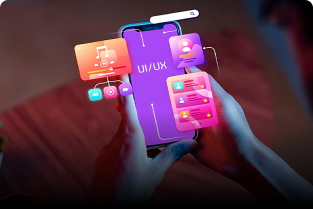Artificial intelligence (AI) is revolutionizing UI design by delivering personalized, intuitive experiences tailored to individual user needs. AI-powered personalization enhances engagement, simplifies navigation, and ensures users feel valued. Here are some of the best examples of how AI is being used to personalize user interfaces across various platforms and industries.
1. Netflix: Personalized Recommendations
Netflix’s AI-driven UI adapts to each user’s viewing habits.
- How It Works: By analyzing your watch history, ratings, and search behavior, AI algorithms recommend movies and TV shows tailored to your preferences.
- UI Impact: The homepage dynamically changes to feature categories and content most relevant to you, increasing engagement.
2. Spotify: Customized Playlists
Spotify’s Discover Weekly and Release Radar playlists are prime examples of AI personalization.
- How It Works: AI analyzes your listening history, favorite genres, and similar user data to create unique playlists.
- UI Impact: Users are greeted with personalized music suggestions that refresh weekly, keeping the experience fresh and engaging.
3. Amazon: Smart Product Recommendations
Amazon’s AI personalizes the shopping experience by offering product suggestions.
- How It Works: AI analyzes browsing history, past purchases, and items in the cart to recommend complementary products.
- UI Impact: The homepage, search results, and checkout process are tailored to highlight items most relevant to each user, boosting conversions.
4. Duolingo: Adaptive Learning Paths
Duolingo uses AI to personalize language learning experiences.
- How It Works: AI tracks user progress, identifies weaknesses, and adjusts lessons accordingly.
- UI Impact: The interface adapts dynamically, ensuring each user’s learning path is unique and optimized for their skill level.
5. Google Maps: Predictive Navigation
Google Maps uses AI to offer tailored travel recommendations.
- How It Works: AI learns your daily routes, preferred modes of transportation, and favorite destinations to provide predictive suggestions.
- UI Impact: The app’s interface prioritizes relevant routes and updates dynamically based on real-time traffic conditions.
6. Facebook: Personalized Feeds
Facebook’s algorithm tailors the content you see in your feed.
- How It Works: AI evaluates your interactions, likes, and social connections to prioritize posts and ads most likely to interest you.
- UI Impact: The feed becomes a unique reflection of your preferences, increasing time spent on the platform.
7. Adobe Creative Cloud: AI-Powered Design Assistance
Adobe’s AI tools, such as Adobe Sensei, personalize the design experience for creative professionals.
- How It Works: AI suggests design elements, color palettes, and layouts based on user preferences and project history.
- UI Impact: The workspace adapts to user needs, speeding up the design process and fostering creativity.
8. Sephora: Virtual Beauty Advisor
Sephora’s AI enhances the shopping experience with personalized beauty recommendations.
- How It Works: AI analyzes your skin type, preferences, and purchase history to recommend products. Virtual try-ons use augmented reality to personalize the shopping journey further.
- UI Impact: The app and website adapt to provide tailored product recommendations and seamless virtual experiences.
9. Grammarly: Contextual Writing Suggestions
Grammarly leverages AI to personalize writing assistance.
- How It Works: AI analyzes your writing style, tone, and intent to offer contextual suggestions for clarity and engagement.
- UI Impact: The interface adapts to display relevant corrections and enhancements, ensuring a personalized editing experience.
10. Pinterest: Visual Discovery Engine
Pinterest’s AI personalizes content recommendations and search results.
- How It Works: By analyzing pins, boards, and user interactions, AI suggests visually similar content tailored to user interests.
- UI Impact: The UI evolves to display relevant pins, making the platform highly engaging and user-friendly.
11. Uber: Personalized Ride Preferences
Uber tailors its app interface to each user’s preferences and behavior.
- How It Works: AI remembers frequently visited locations, preferred ride types, and payment methods to streamline bookings.
- UI Impact: The app adapts its layout and options dynamically to minimize friction during booking.
12. Nike App: Personalized Shopping and Training
The Nike app combines AI with fitness and shopping experiences.
- How It Works: AI analyzes user fitness goals, training history, and shopping habits to recommend workout plans and products.
- UI Impact: Personalized dashboards and interactive features ensure users have an engaging, tailored experience.

